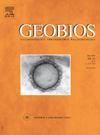翅推进潜水鸟的多样性、古生物学和形态学方面
IF 1.6
4区 地球科学
Q2 PALEONTOLOGY
引用次数: 0
摘要
鸟类的翅膀通常被认为是空中飞行的工具,但众所周知,许多鸟类也会用翅膀在水中推动自己。虽然这种运动方式,即翼推进潜水,已经引起了鸟类学家和古鸟类学家的广泛关注,但对其多样性还缺乏系统的认识。本文试图对这一主题进行概述,从不同的文献中收集信息。尽管人们普遍认为翼推进潜水是一种相对专业的运动模式,但它已经在许多偶然的潜水员以及许多通常被认为是专门的脚推进潜水员的鸟类中得到了证明。翅膀推进潜水员的化石记录揭示了这些鸟类以前未被认识到的形态多样性,尽管如何可靠地推断这种运动模式在已灭绝分类群中的存在仍然存在困难。最近的解剖学研究表明,向翼推进式潜水的进化路径可能比人们从进化趋同的刻板观念中所假设的更为复杂和多样。未来的研究配备了完善的系统发育和复杂的分析技术,无疑将为这种运动模式的进化提供更细致入微的方面。本文章由计算机程序翻译,如有差异,请以英文原文为准。
Aspects of diversity, paleobiology, and morphology of wing-propelled diving birds
Bird wings are typically regarded as an apparatus for aerial flight, but many birds are known to use their wings to propel themselves in the water. Although this mode of locomotion, the wing-propelled diving, has attained much attention from ornithologists and paleornithologists, systematic understanding of its diversity has been lacking. This paper attempts to provide an overview on this topic, gleaning information from disparate bodies of literature. Despite the common perception that wing-propelled diving is a relatively specialized mode of locomotion, it has been documented in a number of casual divers as well as many birds usually considered as specialized foot-propelled divers. The fossil record of wing-propelled divers reveals a previously unrecognized morphological diversity in these birds, although difficulty remains on how to reliably infer the presence of this locomotor mode in extinct taxa. Recent anatomical studies have indicated that evolutionary pathways toward wing-propelled diving can be more complicated and diverse than one would assume from the stereotypic idea of evolutionary convergence. Future investigations equipped with well-resolved phylogeny and sophisticated analytical techniques will undoubtedly shed light into more nuanced aspects of the evolution of this mode of locomotion.
求助全文
通过发布文献求助,成功后即可免费获取论文全文。
去求助
来源期刊

Geobios
地学-古生物学
CiteScore
3.30
自引率
6.20%
发文量
28
审稿时长
6-12 weeks
期刊介绍:
Geobios publishes bimonthly in English original peer-reviewed articles of international interest in any area of paleontology, paleobiology, paleoecology, paleobiogeography, (bio)stratigraphy and biogeochemistry. All taxonomic groups are treated, including microfossils, invertebrates, plants, vertebrates and ichnofossils.
Geobios welcomes descriptive papers based on original material (e.g. large Systematic Paleontology works), as well as more analytically and/or methodologically oriented papers, provided they offer strong and significant biochronological/biostratigraphical, paleobiogeographical, paleobiological and/or phylogenetic new insights and perspectices. A high priority level is given to synchronic and/or diachronic studies based on multi- or inter-disciplinary approaches mixing various fields of Earth and Life Sciences. Works based on extant data are also considered, provided they offer significant insights into geological-time studies.
 求助内容:
求助内容: 应助结果提醒方式:
应助结果提醒方式:


